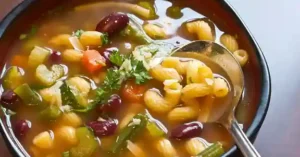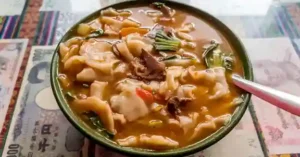Puerto Rican chicken soup, or Sopa de Pollo Boricua, is a comforting and flavorful dish that sets itself apart from regular chicken soup. Packed with bold seasonings, tender chicken, and fideos (short noodles), it’s a true reflection of Puerto Rican home cooking. This soup is more than a meal—it’s a warm hug in a bowl. Ready to explore the rich flavors and simple steps to create this beloved dish? Let’s dive in!

Introduction to Puerto Rican Chicken Soup (Sopa de Pollo Boricua)
Puerto Rican chicken soup, also known as Sopa de Pollo Boricua, is a traditional dish deeply rooted in Puerto Rican culture. Unlike typical chicken soups, this version incorporates distinct seasonings and ingredients that give it a unique depth of flavor. The foundation of this dish is the classic sofrito, a blend of onions, peppers, garlic, and herbs, which serves as the aromatic base for many Puerto Rican recipes.
One of the key differences in Puerto Rican chicken soup is the use of fideos, a thin noodle often used in Latin cuisine, which adds a hearty texture. The broth is enriched with a blend of spices, like cumin and oregano, that sets it apart from the lighter, simpler broths found in more traditional chicken soups. Additionally, the use of bone-in chicken is preferred, as it imparts a richer flavor and a deeper, more satisfying broth.
While most chicken soups focus on basic vegetables like carrots and celery, Sopa de Pollo Boricua may also include root vegetables like yuca or plantains, adding a unique tropical twist. This balance of flavors and textures creates a soup that is comforting, robust, and packed with nutrients.

Key Ingredients for Puerto Rican Chicken Soup Recipe
The magic of Puerto Rican chicken soup, or Sopa de Pollo Boricua, lies in its fresh, vibrant ingredients. Each component plays a vital role in creating a flavorful, hearty dish that stands out from typical chicken soups. Here’s a breakdown of the essential ingredients and their significance in this beloved recipe:
Bone-In Chicken
Using bone-in chicken, usually thighs or drumsticks, is critical for this dish. As the chicken cooks, the bones release collagen and flavor into the broth, giving it a rich, hearty taste that boneless cuts can’t match. The tender, juicy chicken also absorbs the seasonings, making each bite packed with flavor.
Sofrito
Sofrito is the heart of many Puerto Rican dishes, and this soup is no exception. It’s a fragrant mix of onions, garlic, peppers (often sweet or bell peppers), cilantro, and sometimes tomatoes. Sofrito acts as the base of the soup, giving it a burst of savory, aromatic flavor that’s instantly recognizable in Puerto Rican cuisine.
Fideos (Thin Noodles)
Fideos are short, thin noodles commonly used in Latin and Spanish soups. They provide a satisfying texture and soak up the flavors of the broth, making them a key ingredient in Sopa de Pollo Boricua. If fideos aren’t available, you can substitute with vermicelli or broken spaghetti, but fideos are preferred for authenticity.
Root Vegetables
To add depth and heartiness, Puerto Rican chicken soup often includes root vegetables such as yuca, potatoes, or even plantains. These starchy ingredients soak up the broth and add a slightly sweet, earthy flavor, balancing the richness of the chicken and sofrito.
Seasonings and Spices
Puerto Rican chicken soup is seasoned generously with a blend of spices, which contribute to its bold, layered flavor:
- Cumin: Adds warmth and a slightly smoky undertone.
- Oregano: Provides a herbaceous note, enhancing the earthy flavors.
- Bay Leaves: Infuse the broth with a subtle aromatic flavor.
- Adobo Seasoning: A Puerto Rican staple, adobo typically includes a mix of garlic powder, onion powder, and black pepper, adding a burst of umami to the soup.
Tomato Sauce
A small amount of tomato sauce is often added to give the broth a touch of acidity and a slightly richer color. While not overwhelming, the tomato helps balance the stronger seasonings and brings all the flavors together.
Fresh Cilantro
Fresh cilantro is added at the end of cooking, brightening the dish with a fresh, citrusy note. Its vibrant green color and distinct flavor enhance the overall presentation and taste.
Fideo Substitutions
If you can’t find fideos, there are several suitable replacements:
- Vermicelli: Thin pasta that resembles fideos in both texture and cooking time.
- Angel Hair Pasta: Break this into short pieces to mimic the shape and size of fideos.
- Spaghetti: While thicker, spaghetti can be broken into small pieces and used in a pinch.

Chicken Seasoning and Preparation
The seasoning and preparation of the chicken are crucial to capturing the authentic flavors of Sopa de Pollo Boricua. Puerto Rican chicken soup relies on well-seasoned chicken and a careful cooking process that ensures maximum flavor infusion in the broth. Here’s how to properly season and prepare the chicken for the perfect bowl of soup:
Marinating the Chicken
For the most flavorful result, marinating the chicken before cooking is highly recommended. This step allows the chicken to absorb the spices fully, resulting in tender, flavorful meat and a rich broth. The basic chicken seasoning includes:
- Adobo: A classic Puerto Rican seasoning blend. It’s typically made from garlic powder, onion powder, salt, black pepper, and sometimes oregano and turmeric. This is the go-to for seasoning poultry, providing a robust, savory flavor base.
- Sazón: Another essential seasoning in Puerto Rican cooking. Sazón typically includes ground annatto (achiote) for color, garlic, coriander, and cumin. It enhances both the flavor and the color of the chicken.
- Garlic: Fresh garlic is often added along with powdered forms. It adds depth and richness to the chicken’s flavor.
- Cilantro or Culantro: Adding chopped cilantro or the more intense culantro (similar to cilantro but with a bolder flavor) to the marinade brings a fresh, herbal note that cuts through the richness of the meat.
Marinate the chicken for at least 30 minutes, but ideally, allow it to sit for a few hours or overnight for deeper flavor.
Browning the Chicken
Once marinated, browning the chicken is an important step in developing flavor. Start by heating a small amount of oil in a large pot or Dutch oven. Brown the chicken pieces (with the bone-in) on both sides until golden. This step caramelizes the exterior, locking in the seasoning and juices, while creating flavorful browned bits at the bottom of the pot (called fond), which will later enrich the broth.
Browning isn’t meant to fully cook the chicken, but rather to start building layers of flavor for the soup. The chicken will finish cooking as it simmers in the broth.
Adding the Sofrito
After browning the chicken, the next step is to sauté the sofrito in the same pot. This traditional Puerto Rican flavor base consists of:
- Onions
- Garlic
- Bell peppers
- Cilantro or culantro
- Tomato (optional)
Add the sofrito to the browned bits left in the pot from the chicken. Stirring frequently, allow it to cook down for a few minutes, until the vegetables are soft and fragrant. The sofrito will absorb the fond, creating a rich, flavorful base for the soup. This step ensures that the flavors from the chicken and the sofrito meld beautifully.
Simmering the Chicken in Broth
After the sofrito is cooked, the chicken is added back into the pot along with water or chicken broth to simmer. Bone-in chicken releases natural collagen into the liquid, thickening the broth slightly and giving it a velvety texture. The slow simmering allows the chicken to tenderize while the flavors intensify, creating a deeply rich and flavorful soup.
Add seasonings like:
- Bay leaves: A subtle aromatic that adds complexity.
- Oregano and cumin: For earthy, warming notes.
- Tomato sauce: Adds a slight acidity and richness to the broth, balancing the spices.
The chicken should simmer for about 30–40 minutes until it becomes fall-off-the-bone tender.
Shredding the Chicken (Optional)
Some versions of Sopa de Pollo Boricua call for the chicken to be shredded once it’s cooked through. This allows the meat to better absorb the flavors of the broth and distributes the chicken more evenly throughout the soup. You can either shred the chicken completely or leave the pieces whole for a heartier presentation.
If you choose to shred, remove the chicken from the pot after simmering and let it cool slightly before shredding it with a fork. Then, return the shredded chicken to the soup to continue simmering.
Final Seasoning Adjustments
Taste the broth before serving to check for seasoning. You may need to add additional:
- Salt and pepper: To enhance the flavors.
- Fresh cilantro: Stirred in at the end for a bright, fresh finish.
- Lime juice (optional): For a citrusy zing that cuts through the richness of the soup.

Step-by-Step Recipe Instructions
Making Puerto Rican chicken soup (Sopa de Pollo Boricua) is a rewarding process that transforms simple ingredients into a flavorful, nourishing dish. Follow these detailed step-by-step instructions to create the perfect bowl of soup:
Prepare the Ingredients
Before you start cooking, gather and prep all of your ingredients. Having everything ready will streamline the cooking process.
- Chicken: Use bone-in chicken pieces, preferably thighs and drumsticks for richer flavor.
- Sofrito: Prepare the sofrito by finely chopping onions, bell peppers, garlic, cilantro, and culantro. You can also use pre-made sofrito from a jar if available.
- Fideos: Measure out the fideos or alternative noodles like vermicelli or broken spaghetti. Set aside.
- Vegetables: Peel and chop root vegetables such as yuca, potatoes, or plantains if using. These add extra heartiness and flavor to the soup.
Marinate the Chicken
Season the chicken with a blend of:
- Adobo (a mix of garlic powder, onion powder, black pepper, and salt).
- Sazón (to give the chicken flavor and a vibrant color).
- Fresh garlic, cilantro, and a squeeze of lime (optional).
Let the chicken marinate for at least 30 minutes, or up to a few hours for maximum flavor.
Brown the Chicken
Heat a tablespoon of oil in a large pot or Dutch oven over medium heat. Add the marinated chicken pieces, skin-side down, and brown them on both sides. This step will caramelize the exterior of the chicken, locking in its juices and enhancing the flavor of the broth.
- Tip: Don’t overcrowd the pot—brown the chicken in batches if necessary. Once browned, remove the chicken and set aside.
Cook the Sofrito
In the same pot, add the prepared sofrito mixture (onions, garlic, bell peppers, cilantro). Cook the vegetables in the chicken drippings over medium heat, stirring occasionally, until they soften and become fragrant (about 5 minutes). If needed, add a splash of oil to prevent sticking. The sofrito will start absorbing the flavorful bits left from the browned chicken, which helps create a richer base for the soup.
Deglaze the Pot
After the sofrito has cooked down, add a small amount of tomato sauce (about 2–3 tablespoons) and cook for another 2 minutes. The tomato sauce will add richness and a slight acidity to the soup. Deglaze the pot by pouring in a cup of water or chicken broth. Use a wooden spoon to scrape up any browned bits stuck to the bottom of the pot. These bits, known as fond, are packed with flavor and will infuse the broth.
Add the Chicken and Broth
Return the browned chicken to the pot, placing it on top of the sofrito mixture. Pour enough chicken broth (or water) into the pot to completely cover the chicken, typically about 6–8 cups.
Add seasonings like:
- Bay leaves (2–3)
- Ground cumin (1 teaspoon)
- Dried oregano (1 teaspoon)
- Adobo seasoning (to taste)
Stir gently to combine everything, then bring the mixture to a boil.
Simmer the Soup
Once the soup reaches a boil, reduce the heat to low and let it simmer. Cover the pot partially and allow the chicken to cook slowly for about 30–40 minutes. This simmering process is key to developing a rich, flavorful broth while ensuring the chicken becomes tender and juicy.
- Tip: Skim off any foam or fat that rises to the surface during cooking to keep the broth clear.
Add the Vegetables
After the chicken has simmered for about 20 minutes, add the chopped root vegetables like yuca, potatoes, or plantains. These starchy vegetables will help thicken the broth slightly and add heartiness to the soup. Simmer until the vegetables are tender, usually another 15–20 minutes.
Cook the Fideos
About 10 minutes before serving, add the fideos or any other noodles you’re using to the pot. Stir gently to make sure the noodles are evenly distributed. Cook the noodles for about 8–10 minutes, or until they are tender but still hold their shape.
- Note: If using a different type of noodle, adjust the cooking time according to the package instructions.
Adjust the Seasoning
Taste the broth and adjust the seasoning as needed. Add salt, pepper, or more adobo if necessary. If you like a brighter flavor, squeeze in a bit of fresh lime juice or add more cilantro for a fresh, herbal note.
Shred the Chicken (Optional)
If you prefer, you can remove the chicken from the pot once it’s fully cooked and shred it using two forks. This step ensures that every spoonful of soup contains tender chicken. Alternatively, you can leave the chicken pieces whole for a more rustic presentation.
Serve the Soup
Ladle the soup into bowls, making sure each bowl gets a good mix of broth, chicken, noodles, and vegetables. Garnish with fresh cilantro or a squeeze of lime juice for an extra burst of freshness.
Optional Garnishes
- Freshly chopped cilantro
- Sliced avocado
- Lime wedges
- A drizzle of olive oil for added richness

Cooking Equipment Needed
To make Puerto Rican chicken soup (Sopa de Pollo Boricua), you’ll need a few essential tools to ensure the soup is prepared efficiently and with maximum flavor. Below is a breakdown of the key equipment required for making this comforting dish:
Large Pot or Dutch Oven
A large pot or Dutch oven is essential for cooking the soup. It needs to be big enough to hold the chicken, broth, vegetables, and noodles while allowing space for simmering. A heavy-bottomed pot or enameled Dutch oven works best because it evenly distributes heat, prevents burning, and holds in moisture, creating a rich and flavorful broth.
- Capacity: At least 6–8 quarts to comfortably fit all the ingredients.
- Material: Stainless steel or cast iron with an enamel coating is ideal for even cooking and heat retention.
Wooden Spoon or Spatula
A wooden spoon or spatula is useful for stirring the sofrito, deglazing the pot, and gently mixing the soup as it simmers. Wooden utensils are gentle on the pot’s surface and help avoid scratching, especially if using a non-stick or enameled Dutch oven.
- Tip: Use the spoon to scrape up the flavorful browned bits from the bottom of the pot after browning the chicken. These bits add depth to the soup.
Tongs
Tongs are necessary for handling the chicken. Use them to easily flip the chicken when browning it and to remove or shred the chicken once it’s cooked. Tongs help you move the chicken without piercing the meat, which helps retain its juices.
- Tip: Choose long, heat-resistant tongs to avoid burns when handling the chicken over high heat.
Chef’s Knife
A good-quality chef’s knife is essential for chopping vegetables, herbs, and meat. You’ll use it to prepare the sofrito, chop root vegetables, and possibly cut the chicken into smaller pieces.
- Blade length: A 6- to 8-inch blade is ideal for most tasks.
- Sharpness: Ensure your knife is sharp to make quick, even cuts, especially when dealing with tough root vegetables like yuca or plantains.
Cutting Board
Use a sturdy cutting board for chopping vegetables, herbs, and preparing the chicken. A large, stable cutting board provides enough space to safely and efficiently prepare all the ingredients.
- Tip: Use a separate board for raw chicken to avoid cross-contamination. Plastic boards are easier to sanitize after handling raw poultry.
Measuring Cups and Spoons
Accurate measurements are important for achieving the right balance of flavors in the soup. Measuring cups are used for liquids like broth or water, and measuring spoons ensure precise amounts of spices, like adobo, cumin, and oregano.
- Tip: Use liquid measuring cups for broth and water, and dry measuring cups for solid ingredients like fideos or vegetables.
Ladle
A ladle is essential for serving the soup. It helps you scoop out the right amount of broth, chicken, vegetables, and noodles into each bowl without making a mess. A long-handled ladle is especially useful when dealing with a large pot of hot soup.
- Tip: Choose a ladle with a deep bowl for easy serving, and one with a pouring lip to avoid spills.
Strainer or Skimmer (Optional)
A strainer or skimmer can be useful for removing any foam or fat that rises to the surface as the soup simmers. This keeps the broth clear and free of excess grease.
- Tip: Use a fine-mesh skimmer for easily removing small impurities from the broth while cooking.
Shredder Forks (Optional)
If you plan to shred the chicken after it has cooked, forks with sharp tines or shredding claws can make the process quicker and more efficient. They help you pull apart the tender chicken without burning your hands.
- Tip: Let the chicken cool slightly before shredding to avoid losing too much moisture.
Immersion Blender (Optional)
While not traditionally used in Sopa de Pollo Boricua, some cooks prefer a slightly thicker broth. If you want a richer, thicker texture, you can use an immersion blender to blend a small portion of the soup after it’s cooked, being careful to leave the chicken and noodles intact.
- Tip: Blend only a small portion of the broth and vegetables for a creamier consistency, but be cautious not to over-blend.
Optional Tools:
Citrus Juicer (Optional)
If you plan to finish the soup with a squeeze of fresh lime juice, a citrus juicer or hand-held reamer can make the task easier and ensure you get the most juice from your limes.
- Tip: Fresh lime juice adds a bright, zesty finish to balance the richness of the broth.
Kitchen Timer
Keeping track of cooking times is key for making sure the chicken is perfectly tender and the vegetables are cooked through without becoming mushy. A kitchen timer helps you monitor simmering and cooking times without guesswork.
- Tip: Set timers for different stages of the cooking process, like simmering the chicken, adding vegetables, and cooking the noodles.

Recipe Variations
While Sopa de Pollo Boricua has a classic recipe, there are several variations you can explore to suit different tastes or preferences. These variations allow for flexibility in ingredients and techniques, making the soup adaptable for different dietary needs, regional ingredients, or personal preferences. Below are some common and creative variations you can try.
Sopa de Pollo Con Fideos (Chicken Noodle Soup)
This is one of the most popular variations of Puerto Rican chicken soup. In this version, traditional thin noodles called fideos are added to the broth, making it more hearty and satisfying. The noodles cook directly in the soup, soaking up the flavors of the broth. For this variation:
- Substitute noodles: If you don’t have fideos, you can use vermicelli, angel hair pasta, or even broken spaghetti.
- Tip: Add the noodles toward the end of cooking to prevent them from becoming too soft or mushy.
Sopa de Pollo Con Mofongo
Mofongo is a Puerto Rican dish made from mashed fried plantains, often seasoned with garlic, pork cracklings (chicharrón), or bacon. When combined with Sopa de Pollo, mofongo adds a starchy, garlicky richness that complements the soup’s savory broth.
- How to make it: Fry green plantains until golden, then mash them with garlic, olive oil, and cracklings or bacon. Form the mixture into small balls and add them to individual bowls of soup.
- Tip: Serve the soup with a mofongo ball on the side or directly in the soup for a satisfying, traditional twist.
Sopa de Pollo Con Arroz (Chicken Soup with Rice)
For a more filling version, you can add rice to Sopa de Pollo Boricua. The rice absorbs the broth’s flavors, making it a heartier meal. This version is similar to Puerto Rican chicken and rice stew but remains lighter due to the soup’s broth base.
- Rice type: Medium-grain rice works best as it holds up well in soup. You can also use long-grain or even brown rice for added texture.
- Tip: Add the rice after the chicken has been simmering, allowing it to cook in the broth until tender.
Sopa de Pollo with Root Vegetables
Many variations of Sopa de Pollo feature Puerto Rican root vegetables like yuca, yautía, malanga, or plantains. These vegetables add texture and heartiness to the soup and provide a deeper, earthy flavor.
- Vegetable selection: Use a combination of root vegetables to make the soup more robust. Yuca adds a mild, starchy flavor, while malanga provides a nutty taste.
- Tip: Be sure to cut the vegetables into uniform pieces so they cook evenly.
Sopa de Pollo with Corn and Sweet Potatoes
For a sweeter and more colorful twist, try adding fresh corn and sweet potatoes to your soup. Corn adds a subtle sweetness and texture, while sweet potatoes provide a creamy, soft element that complements the savory chicken broth.
- How to add: Cut the sweet potatoes into cubes and add them to the soup halfway through the cooking process. Fresh corn can be sliced into rounds or kernels and added at the same time.
- Tip: For a spicy kick, add a pinch of cayenne pepper or a chopped jalapeño.
Spicy Sopa de Pollo
If you prefer your soup with a bit of heat, you can make a spicy version of Sopa de Pollo. This variation incorporates ingredients like:
- Chopped jalapeños or habaneros: Add them to the sofrito for a spicier base.
- Crushed red pepper flakes: Stirred into the broth for a subtle heat that builds as the soup simmers.
- Tip: Balance the heat with fresh cilantro, lime juice, or avocado for a cooling contrast.
Sopa de Pollo with Coconut Milk
For a Caribbean twist, you can add coconut milk to the broth. This variation creates a creamy, slightly sweet soup with a tropical flair. Coconut milk pairs well with the savory chicken and adds a luscious texture to the soup.
- How to use: Substitute one cup of water or broth with coconut milk and stir it in during the simmering process. Be careful not to boil the soup too vigorously once the coconut milk is added, as it can curdle.
- Tip: Garnish with cilantro and a splash of lime juice to enhance the tropical flavors.
Vegetarian Sopa (Sopa de Vegetales)
For a meatless variation, you can easily adapt Sopa de Pollo Boricua into a vegetarian or vegan-friendly soup by skipping the chicken and using vegetable broth. To make the soup more substantial, include protein-rich vegetables and beans, such as:
- Chickpeas or black beans: Add them toward the end of cooking for extra texture and protein.
- Vegetable options: Use heartier vegetables like squash, zucchini, bell peppers, and carrots to add bulk to the soup.
- Tip: You can also incorporate tofu or plant-based chicken substitutes for a similar texture and protein content.
Mexican-Inspired Sopa de Pollo
For a Mexican twist on Sopa de Pollo, consider adding Mexican spices and ingredients such as:
- Cumin and coriander: To enhance the earthy flavors in the soup.
- Lime juice and avocado: Garnish with these for a refreshing and creamy contrast.
- Chopped cilantro and fresh jalapeños: Add them for extra flavor and spice.
Sopa de Pollo with Egg Drop
A unique variation includes adding an egg drop to the soup, which gives it a silky texture. This variation is inspired by other noodle soups where lightly beaten eggs are slowly stirred into the simmering broth, creating delicate ribbons of egg throughout the soup.
- How to add: Lightly beat two eggs in a small bowl. Slowly drizzle the eggs into the hot broth while stirring the soup to create the egg drop effect.
- Tip: Add the egg right before serving to prevent it from overcooking.

Storage and Reheating Tips
Properly storing and reheating Sopa de Pollo Boricua ensures that you can enjoy this delicious soup for days without compromising on flavor or texture. Here’s how to store and reheat the soup safely while maintaining its quality.
Refrigerating Instructions
After you’ve enjoyed your soup, any leftovers should be cooled and stored properly. Follow these steps to refrigerate the soup:
Cool the Soup:
Allow the soup to cool at room temperature for about 30 minutes before refrigerating. Don’t leave it out for more than 2 hours to avoid bacterial growth.
Portion the Soup:
Transfer the soup into airtight containers. If possible, divide the soup into smaller portions for easier reheating later.
Storage Time:
Store the soup in the refrigerator for up to 3–4 days. The flavors will continue to develop, making the soup even tastier the next day.
- Note: If the soup contains noodles or rice, they may absorb much of the broth over time. To prevent mushiness, you can store the noodles or rice separately from the broth and chicken.
Freezing Instructions
Sopa de Pollo Boricua freezes well, making it a perfect meal to prepare in advance or to save for a busy day. Follow these steps for freezing:
- Cool the Soup Completely: Before freezing, make sure the soup has cooled down completely to avoid condensation in the container, which can cause freezer burn.
- Use Freezer-Safe Containers: Transfer the cooled soup into freezer-safe, airtight containers or heavy-duty resealable plastic bags. Leave about an inch of space at the top, as the liquid will expand when frozen.
- Freeze in Portions: If you plan to defrost only small amounts at a time, portion the soup into individual servings before freezing. This makes it easier to reheat only what you need.
- Label the Containers: Write the date on each container so you can keep track of how long the soup has been frozen. Soup can be safely frozen for up to 3 months.
- Tip: If the soup contains noodles, consider freezing the broth and chicken separately from the noodles. This prevents the noodles from becoming overly soft when reheated. Cook fresh noodles when you’re ready to serve the thawed soup.
Reheating Instructions
Reheating Sopa de Pollo properly will ensure that it retains its original flavor and texture. Follow these reheating methods depending on whether your soup is refrigerated or frozen.
For Refrigerated Soup:
Stovetop Method:
The stovetop is the best method for reheating soup because it heats evenly and allows you to monitor the temperature. Pour the soup into a pot and heat over medium heat, stirring occasionally. If the soup has thickened while in the fridge, add a little chicken broth or water to loosen it up. Once the soup reaches a simmer, check to ensure that the chicken is heated through and the vegetables are warmed evenly.
Microwave Method:
For a quicker option, use the microwave. Pour a portion of the soup into a microwave-safe bowl. Cover the bowl with a microwave-safe lid or plate to avoid splattering. Heat the soup in 1–2 minute intervals, stirring in between to distribute the heat evenly. Make sure the soup is hot all the way through before serving, but be cautious not to overheat and dry out the chicken.
For Frozen Soup:
Thaw the Soup:
If possible, move the frozen soup from the freezer to the refrigerator the night before you plan to eat it. This will allow it to thaw gently and evenly. If you’re in a hurry, you can place the sealed container in a bowl of cold water to speed up the thawing process. Alternatively, you can microwave the frozen soup in short bursts to thaw it before reheating.
Reheating Frozen Soup on the Stovetop:
Once the soup is thawed, transfer it to a pot. Heat it over medium heat, stirring occasionally until it reaches a gentle simmer. If the soup has thickened, add some water or chicken broth to restore the desired consistency.
Reheating Frozen Soup in the Microwave:
Place the frozen or partially thawed soup in a microwave-safe bowl. Use the defrost setting or microwave on low power to slowly thaw and heat the soup. Once thawed, increase the heat and microwave in 1-minute intervals, stirring in between to ensure even heating.
Tip: If you notice that the broth has become overly thick after reheating, thin it out with a bit of fresh chicken broth or water to bring it back to its original consistency.
Storing and Reheating Noodles or Rice Separately
If you’re storing soup that contains noodles or rice, keep in mind that these ingredients will continue to absorb the broth as they sit, potentially becoming mushy. Here’s how to handle this:
- Store Separately: If possible, store the noodles or rice in a separate container from the broth. This will keep them from absorbing too much liquid.
- Reheat Separately: Reheat the broth and chicken as usual, and then reheat the noodles or rice separately in the microwave or by briefly warming them in the soup after it has been reheated.
- Fresh Noodles: For best results, you can cook fresh noodles or rice each time you reheat the soup. This will keep the texture perfect.
Additional Tips for Storing and Reheating Soup
- Avoid Overcooking: When reheating the soup, be careful not to boil it for too long, as this can cause the chicken to dry out and the vegetables to become too soft.
- Garnishing Freshly: If your soup was originally garnished with fresh herbs or lime juice, add these garnishes only after reheating for the best flavor and presentation.
- Reheating with Mofongo: If your soup includes mofongo, reheat the mofongo separately in the microwave or oven. Then, serve it fresh in the reheated soup to maintain its texture.

Nutrition Information
Understanding the nutritional aspects of Sopa de Pollo Boricua is important for maintaining a balanced diet while enjoying this delicious dish. The nutrition information will vary based on the specific ingredients used and the portion sizes, but here’s a general overview of the key components and their health benefits.
Nutritional Breakdown (Per Serving)
A typical serving of Sopa de Pollo Boricua (about 1 cup) may include the following approximate nutritional values, though these can vary based on specific recipes and ingredient choices:
- Calories: 250–350 kcal
- Protein: 20–30 g
- Total Fat: 7–15 g
- Saturated Fat: 2–4 g
- Carbohydrates: 30–40 g
- Dietary Fiber: 2–5 g
- Sugars: 2–4 g
- Sodium: 500–900 mg
- Vitamin A: 10–20% DV
- Vitamin C: 15–25% DV
- Calcium: 5–10% DV
- Iron: 10–15% DV
Key Nutrients and Their Benefits
Sopa de Pollo Boricua is not just comforting; it’s also packed with nutrients that can provide various health benefits:
Protein:
Chicken is an excellent source of lean protein, which is essential for muscle repair and growth, as well as overall bodily functions. A serving of chicken can provide nearly half of the daily protein needs for an average adult.
Vitamins and Minerals:
- Vitamin A: Carrots and other vegetables used in the soup provide vitamin A, important for eye health, immune function, and skin health.
- Vitamin C: Ingredients like bell peppers and tomatoes are rich in vitamin C, which supports immune function and helps in the absorption of iron.
- B Vitamins: Chicken, root vegetables, and herbs contribute various B vitamins, which are vital for energy metabolism and maintaining healthy nerve function.
Healthy Fats:
Olive oil or other healthy fats used in the preparation provide monounsaturated fats, which can support heart health and reduce inflammation.
Fiber:
Adding vegetables and whole grains (like brown rice or whole-grain noodles) increases the fiber content, promoting healthy digestion and helping to maintain a feeling of fullness.
Adjusting Nutritional Content
You can modify the nutritional profile of Sopa de Pollo Boricua based on dietary needs or preferences:
- Lower Sodium: To reduce sodium content, use low-sodium chicken broth and limit added salt. Fresh herbs and spices can enhance flavor without the need for excess salt.
- Increase Fiber: Incorporate more vegetables and whole grains, such as quinoa or barley, to boost fiber content, which aids digestion and helps control blood sugar levels.
- Lean Protein: Use skinless chicken breasts or thighs to lower the fat content, making the soup a leaner protein source.
- Vegetarian/Vegan Option: For a vegetarian or vegan version, replace chicken with tofu or beans and use vegetable broth. This variation will still be rich in protein and fiber while being lower in calories and fat.
Portion Control
Being mindful of portion sizes is essential for managing caloric intake, especially if you’re watching your diet. A standard serving of soup is typically about 1 cup, which provides a balanced amount of nutrients.
Serving Suggestions:
Pair the soup with a side salad or whole-grain bread to create a complete meal without overloading on calories.

Conclusion
In summary, Puerto Rican Chicken Soup (Sopa de Pollo Boricua) is a delightful dish that brings together rich flavors and comforting warmth, making it a staple in Puerto Rican cuisine. With its nourishing ingredients and endless variations, it’s perfect for any occasion, from cozy family dinners to festive gatherings. As you explore this recipe and its storage and serving tips, don’t forget to venture into other delicious chicken dishes that celebrate global culinary traditions. Whether you choose to try Arroz con Pollo, Pollo Guisado, or even Tandoori Chicken, each dish offers its own unique taste experience. So gather your loved ones, dive into these recipes, and savor the joy that comes from sharing hearty meals together. Happy cooking!
[WPSM_AC id=714]
Puerto Rican Chicken Soup Recipe

Discover a delicious Puerto Rican chicken soup recipe that warms the soul! This hearty dish combines tender chicken, vibrant vegetables, and traditional spices for a comforting meal any time of year.
- 1 3-4 lb young chicken
- 1 tbsp natural adobo
- 13 cups water
- 1 tsp apple cider vinegar
- 1 bay leaf
- ½ cup sofrito 4 cubes
- 2 medium-sized potatoes peeled + cut into bite-sized pieces
- 2 carrots diced
- 2 oz Angel hair pasta (omit if you are gluten-free)
- 1 ½ tsp salt or to taste
- Season one 3–4-lb. chicken all over with 1 tbsp adobo.
- Combine chicken with 13 cups of cold water, apple cider vinegar and bay leaf and bring to a simmer over medium-high heat. Cook, reducing heat as needed to maintain a simmer for about 25-30 minutes.
- Carefully lift the whole chicken out of pot and transfer to a cutting board, breast side up. Let it cool until you can handle it.
- Remove the wings, thighs and legs, and then breasts from the chicken carcass
- Pull off and discard any skin from legs and shred the chicken meat into bite-sized pieces. Return legs, breasts, wings, and what is left of the carcass to pot.
- Add the sofrito and your cut up carrots and potatoes to the pot.
- Continue to simmer soup, occasionally skimming fat that rises to the top with large spoon, until the potatoes and carrots are tender. Remove the carcass and break the angel hair pasta in half and add to the soup, cooking for a few minutes until al dente.
- Remove pot from heat. Add salt, and serve hot.
